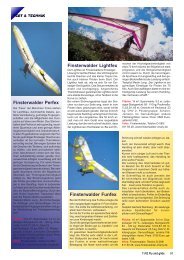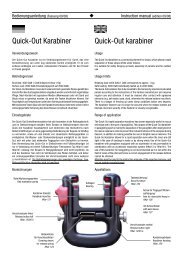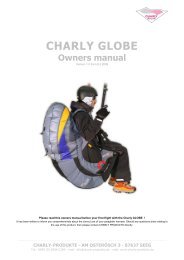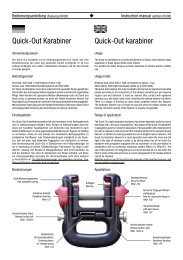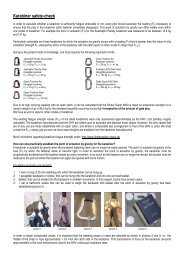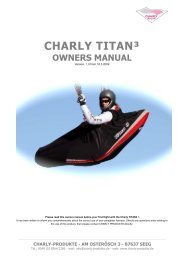Rotor Vulto - Finsterwalder Gmbh
Rotor Vulto - Finsterwalder Gmbh
Rotor Vulto - Finsterwalder Gmbh
You also want an ePaper? Increase the reach of your titles
YUMPU automatically turns print PDFs into web optimized ePapers that Google loves.
OPERATION AND MAINTAINANCE<br />
PUTTING ON THE HARNESS<br />
Stow away your glider cover and harness carrying bag in the compartment at the back of the harness, so that the screws on the back plate are padded. This storage<br />
compartment can be accessed via the left inner zipper. The glider cover fits best into the lower area and the harness carrying bag into the upper area. We find it<br />
easiest to put the harness on like a coat.<br />
Warning: Be sure, that you put your arms through the shoulder straps, not just the neoprene gap seal.<br />
Reach down between your legs and grasp the leg loops. Insert the lower chest tongue through both of the leg loops and fasten to the buckle on the opposite side of<br />
the zipper. Fasten the uppermost chest buckle over the chest pad and zip the centre zipper down to about your navel. Do not zip the zipper too low, as this could<br />
damage it, when the harness spreads open on take off or landing. Shorten the leg loops, so that they are easy to attach, but not overly loose. The shorter they are, the<br />
more flare authority you will have.<br />
The shoulder straps are adjustable and you can add or take out foam blocks in the boot to get the proper fit in length and the centre of gravity in the right place. Do<br />
not over loosen the shoulder straps or you will damage the neoprene gap seal at the neck of the harness. Everyone is built a little differently. It takes some time to<br />
break in the harness and get it adjusted properly.<br />
Warning: Be sure you are holding the base tube with your left hand, when you zip up the harness, as it is common to inadvertently engage the pitch<br />
adjustment lever above your butt and the harness will pitch head down to the limit of the adjustment. If you are not holding the base tube, you can rotate<br />
forward enough, to strike it with your face!<br />
The butt lever is used for small adjustments in your head up or down attitude while prone. To raise your pitch attitude, do a push up on the base tube and then bump<br />
the “butt lever” mounted in the back plate. To lower your pitch attitude, push the “butt lever” and lower yourself to the base tube. Release the lever, when you are at<br />
the pitch attitude you desire.<br />
Shorten the adjustment of the front perlon pitch rope, until it stops you at the furthest head down position you will use when flying. Usually fifteen degrees head down<br />
from level is enough. Shortening the rope in this way will give you more head up adjustment and make the harness safer in a crash.<br />
LAUNCH AND LANDING<br />
The slider at the base of the main support strap is connected to the boot of the harness by two lines. Pushing on the boot will pull the slider backwards. Transference<br />
of the centre of gravity eases transition to a prone position. The KICK ASS mechanism (VULTO/VULTO S) maintains the slider in this position. To get upright for landing, unzip<br />
the harness with the puller on the left side of the harness centre zipper. Drop your knees out of the harness and do a push up on the base tube. Doing this the KICK ASS<br />
mechanism unlocks the slider. You will feel the slider go forward and the harness will pitch up. When the slider is in the forward position, the harness will be inclined<br />
at about 45 degrees. This is the best position for landing. Because the ROTOR has a back plate, it is not possible to get in a straight upright position.<br />
WINCH TOWING<br />
When winch towing we recommend the use of a tow release main rope. When foot launching by UL towing, it may be difficult to attain a sufficiently prone position.<br />
For this reason we recommend the use of a launch trolley when launching behind an UL.<br />
DROGUE PARACHUTES<br />
The ROTOR has a drogue parachute pocket. Be sure to read the drogue parachute instructions before using any type of drogue parachute with this harness.<br />
INSPECTION<br />
Before each flight: Check the parachute lock pins to be sure, they are secure in the bungees.<br />
After every third flight: Check the retentive strength of the reserve chute (whilst on the ground) to prevent soiling of the Velcro.<br />
Before each flight: Inspect the nuts and bolts connecting the back plate and slider.<br />
Before each flight: The slider axle must not be deformed. Tip: In normal flight operation the 12 mm slider axle used by various harness manufacturers has proven<br />
sufficiently robust. Our loading tests carried out by the DHV show, that the slider axle deforms by mid-point loading of more than 3000 N. The tearing-out strength<br />
lays by over 4000 N. Should the slider axle fail, this would result in the pilot subsiding by about 30 cm.<br />
Before each flight: Inspect the mains for any signs of excessive wear or UV-exposure.<br />
MAINTAINANCE<br />
The harness is intended to be used for a duration of 10 years.<br />
By normal usage the harness should be works inspected after 6 years. Duration to additional works inspections are decided by the works.<br />
Lubricate the zippers with silicone spray, whenever the zipper becomes difficult to pull. A light application is all, that is required. Too much silicone will attract and<br />
hold dirt to the zipper and wear the zipper out prematurely.<br />
Keep your harness out of the sun as much as possible. Excessive exposure to UV will cause the harness cloth to fade and loose strength. It may also cause<br />
excessive shrinkage.<br />
Avoid using any harsh chemical solvents or cleaners to clean the harness. We recommend the use of mild soap or water based cleaners.<br />
If the harness becomes wet or soaked, make sure to open up or disassemble the harness as much as necessary, to prevent mould or mildew formation inside the<br />
harness and corrosion on any of the metal surfaces.<br />
If you have any questions, please ring us on 089/8116528 or 08364/1286 or contact us by e-mail (office@finsterwalder-charly.de) or (info@charly-produkte.de)! We<br />
wish you many glorious and, above all, safe flights with your new harness!





